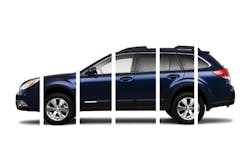Segmenting Your Shop by Repair Type
Small jobs became disruptive to our shop. As a dealership repair center, we do a lot of used car, recon and warranty work. We also get a large volume of walk-in, customer-pay work for things like small bumper repairs. About 35 percent of sales are comprised of light work. But there is high pressure to get those jobs done quickly.
We routinely didn’t reserve enough capacity to get all the small work done consistently. Light jobs would be put on the backburner and sit untouched in the shop. We lost track of where those vehicles were in the system, which caused us to scramble at the last minute and, in some cases, keep cars an extra night at the shop.
To fix it, we decided to implement an entirely new repair philosophy. We split our shop into two categories of work—one for light repairs and one for heavy repairs. The purpose is to improve cycle time by dedicating teams of technicians to specific sizes of jobs from beginning to end, and to move light work out the door within one day.
The light repair category includes every job that requires six labor hours or less. That generally includes small, quick repairs like bumpers, mirrors, door handles, headlights, glass or paintless dent repair. The heavy repair category includes every job that requires more than six labor hours. Each category is comprised of its own team of technicians, dedicated work bays and equipment.
Here’s how our daily production process works using this repair method:
1. Assess the repair. After the estimate is written and uploaded in the management system, a full blueprint and repair plan is developed for the vehicle.
2. Categorize the job. The job is funnelled into the appropriate repair category by assessing the total number of estimated labor hours.
3. Schedule the repair. Each job is prioritized in the shop based on the delivery of parts. The idea is to have technician teams work on each repair from beginning to end without stopping, so we only want to put fully kitted vehicles on the shop floor that have everything necessary to be repaired.
4. Complete the repair. Jobs scheduled in the management system are automatically flagged in the appropriate repair category. Each team of technicians knows which job is next. Teams in each repair category work on the vehicle until it’s fully completed.
Segmenting repairs into categories has significantly improved multiple key performance indicators (KPI). We have increased average daily touch time from 2 hours to 3.4 hours. And that has helped reduce average cycle time by 60 percent, from five days to three. Repair quality and customer satisfaction have improved, too.
Those improvements happen because technicians get really efficient and productive when they focus on one specific type of work. They learn the best and most effective methods for certain repair functions—and develop a strong eye for detail—when they do the same things every day. Cars get fixed faster and more accurately.
You don’t want to implement this repair concept without having a thorough plan. Here are a few things to consider in advance:
1. Job categorization. There are multiple ways to define light and heavy repairs. We base it on labor hours because defining it by monetary value could lead to miscategorizations. For example, headlights on high-end models can cost up to $1,000. It wouldn’t take much more before that becomes a large repair order.
2. Team formation. We needed teams of technicians who could work efficiently as cohesive units. We started by naming one leader for each team. We selected technicians who understood proper material usage, repair processes, and the business significance of KPIs so they could effectively lead each group.
Those leaders “drafted” their own teams of technicians. They each selected equal numbers of A-, B- and C-level technicians based on personality matches. We now have one light repair team with five technicians, and two heavy repair teams with three and four technicians.
3. Technician pay. Each technician earns an hourly rate, in addition to a weekly team production bonus and monthly shop production bonus. We use this plan because it provides incentive for increasing individual and shop productivity while maintaining work quality and team harmony.
4. Dedicated space. Each repair category should have its own, specific area of the shop floor. We simply dedicated four stalls in one corner of the shop to the light repair category. We didn’t make any changes to the structure of our facility.
5. Work mix. Analyze your shop’s current work mix to identify the number of repairs you perform in each category. You need steady amounts of jobs in both categories to keep technicians busy and prevent uneven workloads.
